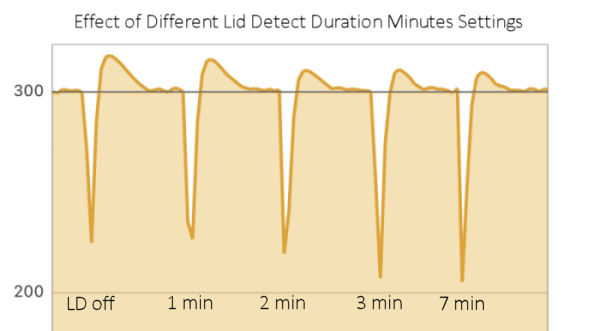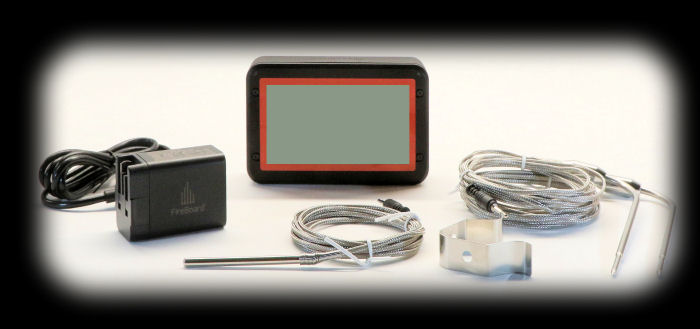| Target |
Accuracy |
Swing |
|---|
| Low |
+1.0° F |
±2.7° F |
| Medium |
+0.6° F |
±3.6° F |
| High |
-0.0° F |
±3.1° F |
|
FireBoard 2 Drive Control Results
As you can see in the table above, the controller performed quite well without having to manually bring your
cooker up to temperature and without having to limit the blower's speed. Compared to all the other
controllers we have tested, the FireBoard controller's performance is pretty good. As far as accuracy goes,
it is in among the best. Its temperature swings are comparable to the majority of controllers, and this amount of
swing is irrelevant when it comes to cooking.
As far as overshoot is concerned, we stopped reporting figures on overshoot long ago because it became
apparent that the size and duration of the typical overshoot was so small as to be irrelevant.
10 degrees over target for 10 minutes isn't going to change anything about your cook or your results.
So all in all, we see no reason not to let the FireBoard
controller manage the startup of your fire and no reason to limit the blower speed. Simply set your
blower damper and upper vent setting appropriately and all will be well. Of course, you are the chef,
so manage your fire/controller as you see fit.
FireBoard 2 Drive Open Lid Results
How well does this controller handle opening the lid of your cooker? This is a slightly tricky question, because
once again, FireBoard is different than every other controller we have seen. Rather than detect the opening of
the lid and then intelligently manage the recovery of the cooker temperature, FireBoard simply turns the blower off for a user
specified period of time.
We test this by getting the cooker stable at a moderate temperature and then opening the lid of the
cooker for 60 seconds before closing the lid. In the case of the FireBoard 2 Drive, we set Lid Detect off
for the first test, then turned it on with Duration Minutes set to 1, 2, 3, and 7 minutes, 7 being the default setting.
Here's the graph showing how it went:
 FireBoard Lid Detect Results |
As you can see, there wasn't a whole lot of difference between the various settings. The curves do look a bit better
for the last 3 tries, so here are the numbers behind the graph:
| Lid Detect Duration | Overshoot | Recovery Time |
| Off | 18.3°F | 13 minutes |
| 1 | 16.3°F | 15 minutes |
| 2 | 11.0°F | 12 minutes |
| 3 | 11.3°F | 11 minutes |
| 7 | 10.0°F | 11 minutes |
FireBoard Lid Detect Results
Indeed, we see the overshoot is between 5 and 8°F less if you set the Duration Minutes greater than 1 minute. The recovery time is
also faster to the tune of 3-4 minutes. So, the difference isn't staggering, but you can probably turn Lid Detect on, set the Duration
Minutes to some value greater than 1 and leave it if you find the difference significant.
Notes On Operating The FireBoard 2 Drive Controller
A few things we'll point out about using the FireBoard 2 Drive controller:
- Alarms are communicated either via notifications, emails or text messages. Alarm conditions do not show up
on the FireBoard unit itself or on the App screen.
- While your FireBoard controller is offline, it will still continue to control your cooker, using the
last known parameters. When the controller returns online, you will then be able to see it in the App or on the web page
and continue monitoring and controlling it from there.
- You can monitor a cook from the web page and a smart device at the same time.
- On the FireBoard unit, you can't set the target pit temperature except from a short list of fixed temperatures. For
any other temperature, you must set the target from the App. On the device, maximum control temperature is only
350°F.
- Firmware updates occur automatically. There is no option to disable them like some other brands.
- You must manually select a channel to control the pit, unlike all other brands that designate a fixed port for the control probe.
Needless to say, you must ensure that you configure the correct channel to control the temperatures.
- Drive settings are only accessible if a blower is plugged in, both on the controller and in the App.
- There is no indication that the controller is charging if it is turned off.
- If you rotate the unit and the screen rotates, the Single Graph, Multi Ttemperature screen shows the probes
right to left instead of left to right. Also, the screen cycles through the channels in reverse order (6-1) when you press button 1,
instead of 1-6.
- There are no alerts or notifications when Lid Detect is active. There is just a tiny icon on the controller display and
"LID" is displayed for the Fan Speed on the App.
- There is no alert for the controller losing Wi-Fi or Bluetooth connectivity. All that happens is that the icons disappear
from the display and App.
- Alarms can only be set from the App, not on the controller itself.
- The controller remembers all the Wi-Fi networks it has connected to in the past and will try to connect to whichever one has
strongest signal.
- Raw data appears to be recorded only when temperatures change versus at fixed intervals. Also, no blower
information is recorded in the raw data.
- A frequently asked question about temperature controllers is whether or not you should leave the adapter installed all the time and if so,
how do you control air flow when you aren't using the unit. You probably don't want to leave the blower installed all the time.
Installing it on your cooker is relatively simple, as is removing it.
- Placement of the pit probe can be important. There are two schools of thought. One is that you want it located near the meat so that the controller is
controlling the temperature at the location of the meat, not somewhere else. However, the probe must not touch the meat and should be at least an inch or
two from the meat. If the meat influences the temperature of the probe (especially when the meat is first placed in the cooker and is cold), obviously
the controller will be sensing a false low pit temperature and will therefore compensate by overstoking the fire. The other school of
thought is that if you are used to cooking by dome temperature (meaning as measured by the thermometer sticking through your dome), then you may wish to
place the pit probe on the stem of your thermometer to control the temperature measured at that location.
Summary
Here is a list of Pro's and Con's we experienced during our testing:
Pros:
- More than adequate temperature control, far better than any indoor oven.
- Monitoring and control possible with App or website.
- Multiple options for probes including more accurate Platinum RTD probes.
- Built-in battery allows you to run your controller without external batteries or power cords.
- Excellent implementation of WiFi setup and connection.
- BlueTooth LE connectivity in addition to WiFi.
- Accurate temperature readings.
- 6 temperature channels, most on the market.
- Large, easy to view display (even in bright sunlight) with multiple display formats.
- Temperature control programming feature allows the more adventurous to experiment
with taking control of cooking profiles.
- Alexa/Google Assistant enabled.
|
Cons:
- The buttons on the side of the controller are hard to locate and press by feel.
- The FireBoard blower is nearly impossible to mount on a small kamado-style cooker with an adapter plate.
- No autoscaling mode on the controller graphs. Only 1m, 30m, 1h, 12h scales are available so, you can't see an
entire cook if it lasts over 12 hours.
- No option for autoscrolling between probe temperatures on the controller. When scrolling through channels using
button 2, it doesn't skip unused channels.
- There is no Ramp Mode or Keep Warm Mode. To accomplish this, you must write a temperature control program.
- No alerts appear on the controller. You must have a smart device to get alerts.
- Cook sessions cannot be stopped and started manually. New sessions are only created when fireboard.io says so.
- You must set App, email and text notifications each and every time you create an alert. No global option available.
- Graphs in the App can be hard to read when you have multiple temperature probes. The colors used are too similar and
shading below each graph line obscures some of the graph lines.
|
The FireBoard 2 Drive temperature controller is a great mid-priced option for BBQ temperature control.
The unit itself offers a display that far exceeds all other brands in quantity and flexibility of data displayed.
It supports six temperature probes, most in the industry, and provides accurate temperature readings. As far
as control of your cooker goes, it is among the best and certainly more than adequate. And its built-in
battery gives the user a lot of freedom to use the unit anywhere, free of the need to plug in or use a battery pack.
The blower mounting is a bit awkward, but the blower itself is powerful enough to control large cookers but can be
damped down for smaller more efficient cookers. So all in all, the FireBoard 2 Drive should be certainly be on your
short list when considering a temperature controller for your outdoor cooker.
Availability
FireBaord products are available from the FireBoard web site and several retailers.
Contact Information
FireBoard Labs
3305 Terrace St, Suite 100
Kansas City, MO 64111
(816) 945-2232
Email: info@fireboard.com
Web: www.fireboard.com
Facebook: www.facebook.com/fireboardlabs
|


